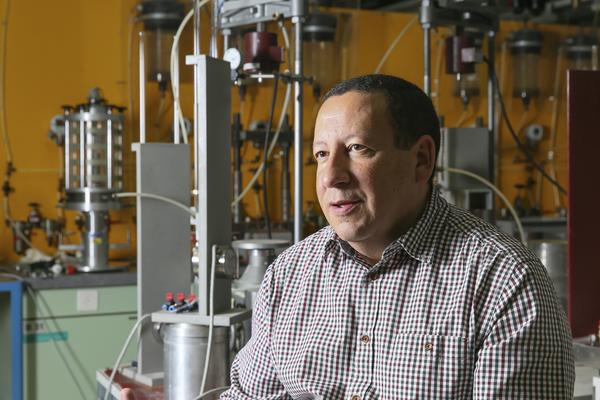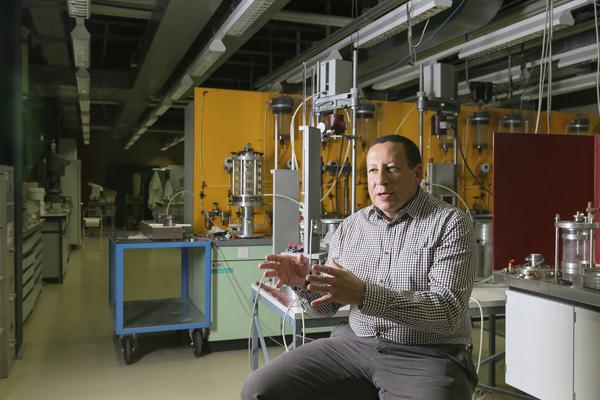Putting carbon back where it came from: underground

© 2015 EPFL – Alain Herzog
Will the future run entirely on renewables? According to Lyesse Laloui, the Paris Climate Conference could be catalytic, but in the meantime, we may have to bury our CO2 emissions underground.
The UN Climate Conference ended with a promising deal to reduce our impact on the climate, ratified by all 190 participating countries. It remains to be seen if and how these ambitious goals will be met. But one thing is for sure: technology will certainly be part of the solution. For example, underground carbon sequestration is among the most mature and proven technologies that could play a crucial role during the transition period that lies ahead until renewable energy becomes the norm, according to Lyesse Laloui, the director of the Petrosvibri Chair in Geoengineering and CO2 Storage. The idea he advocates involves burying our CO2 emissions underground until we are able to get by without them.
Will the decisions taken during the global climate conference boost the development of CO2 sequestration technology?
My first general and positive observation is that there is now a unanimous agreement that the atmosphere is warming, and that, consequently, we have to do something about carbon. In terms of my work, this consensus creates an opportunity. The solution we are working on is not the only one, but it is one that addresses the commitments that were made.
 What role will carbon sequestration play in the future?
What role will carbon sequestration play in the future?
Today, it is the only technology capable of addressing the accumulation of carbon dioxide in the atmosphere. Over 70 projects have proven its feasibility, and since about 15 years, large industrial projects each sequester about one million tons of CO2 underground each year. And unlike oil and gas extraction, CO2 can be sequestered anywhere on the planet.
How would you explain that we don’t rely more on CO2 sequestration, even though it is a mature technology?
The obstacles are primarily financial. Capturing and storing one ton of CO2 costs about 60-70 euros. But it only costs 10 euros to buy certificates to emit a ton of CO2 on the European carbon exchange market. We cannot significantly bring down the cost of carbon capture and sequestration anymore, which his why it will either take a lot of political will or an increase in the price of carbon certificates.
Switzerland expressed its political will by announcing the shutdown of its nuclear power plants. Could CO2 sequestration help facilitate the transition?
Until renewable energy technologies are able to replace nuclear power, Switzerland will not be able to produce enough indigenous power. Gas-powered thermal power plants are being considered to step in, but these emit CO2. Swiss legislation requires that 50% of CO2 emissions produced in such a scenario be compensated on Swiss soil. An efficient transitional solution could be to set up a CO2 capture and storage facility right next to the power plant.
Are the Swiss authorities taking this idea seriously?
For the time being there are no concrete plans to move in this direction. But with support from the Swiss Federal Department of Energy, we are currently working on selecting potential sites to run a full-scale pilot test – 5 to 10,000 tons of CO2 per year – to prove the feasibility of the technology in Switzerland. But we are far from knowing at what pace this will develop.
Technically, how exactly does the technology work?
There are three steps. First, the CO2 has to be captured from the emission source. Next, it has to be concentrated and transported to the storage site. Then comes the final step, in which the CO2 is sequestered underground. To do so, we take advantage of a particularity of CO2: when it is injected into low enough depths, the high temperature and pressure transform it into a so-called “supercritical state”, where it occupies 500 times less volume than when it is a gas!
 Does CO2 sequestration pose any risks?
Does CO2 sequestration pose any risks?
As in all human activities, there are both short- and long-term risks. The short-term risks are primarily due to the pressure at which CO2 is injected underground. This can, for example, lead to the activation of faults that might trigger small earthquakes or allow gas to potentially leak out. We control these risks by understanding the physical mechanisms involved in these processes as well as possible and by developing predictive tools. A longer-term risk is that supercritical CO2, which is highly acidic, could destabilize the geological layers sealing the storage site. But we have technological solutions to prevent such events, either through real-time monitoring or by appropriately designing the projects.
This is also what much of your recent research focuses on.
Indeed. For example, we are investigating the impact of supercritical CO2 on the geological reservoir into which it is injected, in terms of both permeability and resistance of the rock. Aside from that, we are also focusing on the impact on the cap-rock, which is the rock layer that seals the reservoir. In both cases, we are interested in how these rocks react when they come into contact with the acidic supercritical fluid. We are one of the few groups in the world that are able to carry out these types of experiments in the lab. To do so, we developed facilities in which we can reproduce the conditions encountered in depths down to seven kilometers. In another project, we developed tools to appropriately design the installations used to sequester CO2, and to predict the behavior of the rock layers over several years after the gas is injected.
Lyesse Laloui is organizing an international conference at EPFL at the SwissTech Convention Center on greenhouse-gas control technologies in partnership with the International Energy Agency, which will take place in November 2016. Around 2000 participants are expected to attend, including experts from industry and academia, as well as decision-makers. For more information: http://www.ghgt.info/ghgt-13